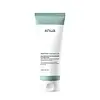What's inside
What's inside
 Key Ingredients
Key Ingredients

 Benefits
Benefits

 Concerns
Concerns

 Ingredients Side-by-side
Ingredients Side-by-side

Water
Skin ConditioningDisodium Cocoamphodiacetate
CleansingSodium Cocoyl Alaninate
Sodium Methyl Cocoyl Taurate
CleansingAcrylates/C10-30 Alkyl Acrylate Crosspolymer
Emulsion StabilisingDisodium 2-Sulfolaurate
CleansingSodium Chloride
MaskingGlycerin
HumectantMethylpropanediol
SolventHouttuynia Cordata Flower/Leaf/Stem Water
AntimicrobialHouttuynia Cordata Extract
Skin ConditioningQuillaja Saponaria Bark Extract
CleansingVincetoxicum Atratum Extract
Skin ConditioningAlthaea Rosea Flower Extract
Skin ConditioningChitosan
1,2-Hexanediol
Skin ConditioningCaprylyl Glycol
EmollientTromethamine
BufferingCoco-Glucoside
CleansingPanthenol
Skin ConditioningSalicylic Acid
MaskingSuccinic Acid
BufferingLauryl Hydroxysultaine
CleansingPolyglyceryl-4 Caprate
EmulsifyingEthylhexylglycerin
Skin ConditioningSodium Cocoyl Isethionate
CleansingSodium Citrate
BufferingSodium Phytate
Hexylene Glycol
EmulsifyingButylene Glycol
HumectantCitric Acid
BufferingProtease
ExfoliatingCaprylic/Capric Triglyceride
MaskingHydrogenated Lecithin
EmulsifyingTocopherol
AntioxidantCeramide NP
Skin ConditioningDipropylene Glycol
HumectantPentylene Glycol
Skin ConditioningCholesterol
EmollientParfum
MaskingWater, Disodium Cocoamphodiacetate, Sodium Cocoyl Alaninate, Sodium Methyl Cocoyl Taurate, Acrylates/C10-30 Alkyl Acrylate Crosspolymer, Disodium 2-Sulfolaurate, Sodium Chloride, Glycerin, Methylpropanediol, Houttuynia Cordata Flower/Leaf/Stem Water, Houttuynia Cordata Extract, Quillaja Saponaria Bark Extract, Vincetoxicum Atratum Extract, Althaea Rosea Flower Extract, Chitosan, 1,2-Hexanediol, Caprylyl Glycol, Tromethamine, Coco-Glucoside, Panthenol, Salicylic Acid, Succinic Acid, Lauryl Hydroxysultaine, Polyglyceryl-4 Caprate, Ethylhexylglycerin, Sodium Cocoyl Isethionate, Sodium Citrate, Sodium Phytate, Hexylene Glycol, Butylene Glycol, Citric Acid, Protease, Caprylic/Capric Triglyceride, Hydrogenated Lecithin, Tocopherol, Ceramide NP, Dipropylene Glycol, Pentylene Glycol, Cholesterol, Parfum
Glycerin
HumectantWater
Skin ConditioningPotassium Cocoyl Glycinate
Sodium Cocoyl Glycinate
CleansingButylene Glycol
HumectantPolyglyceryl-10 Laurate
Skin ConditioningDisodium Laureth Sulfosuccinate
CleansingGlyceryl Stearate Se
EmulsifyingCitric Acid
BufferingGlycol Distearate
EmollientAllantoin
Skin ConditioningDisodium EDTA
Ethylhexylglycerin
Skin ConditioningTetrasodium EDTA
Sodium Hyaluronate
HumectantGluconolactone
Skin ConditioningTocopherol
AntioxidantGlycerin, Water, Potassium Cocoyl Glycinate, Sodium Cocoyl Glycinate, Butylene Glycol, Polyglyceryl-10 Laurate, Disodium Laureth Sulfosuccinate, Glyceryl Stearate Se, Citric Acid, Glycol Distearate, Allantoin, Disodium EDTA, Ethylhexylglycerin, Tetrasodium EDTA, Sodium Hyaluronate, Gluconolactone, Tocopherol
 Reviews
Reviews

Ingredients Explained
These ingredients are found in both products.
Ingredients higher up in an ingredient list are typically present in a larger amount.
Butylene Glycol (or BG) is used within cosmetic products for a few different reasons:
Overall, Butylene Glycol is a safe and well-rounded ingredient that works well with other ingredients.
Though this ingredient works well with most skin types, some people with sensitive skin may experience a reaction such as allergic rashes, closed comedones, or itchiness.
Learn more about Butylene GlycolCitric Acid is an alpha hydroxy acid (AHA) naturally found in citrus fruits like oranges, lemons, and limes.
Like other AHAs, citric acid can exfoliate skin by breaking down the bonds that hold dead skin cells together. This helps reveal smoother and brighter skin underneath.
However, this exfoliating effect only happens at high concentrations (20%) which can be hard to find in cosmetic products.
Due to this, citric acid is usually included in small amounts as a pH adjuster. This helps keep products slightly more acidic and compatible with skin's natural pH.
In skincare formulas, citric acid can:
While it can provide some skin benefits, research shows lactic acid and glycolic acid are generally more effective and less irritating exfoliants.
Most citric acid used in skincare today is made by fermenting sugars (usually from molasses). This synthetic version is identical to the natural citrus form but easier to stabilize and use in formulations.
Read more about some other popular AHA's here:
Learn more about Citric AcidEthylhexylglycerin (we can't pronounce this either) is commonly used as a preservative and skin softener. It is derived from glyceryl.
You might see Ethylhexylglycerin often paired with other preservatives such as phenoxyethanol. Ethylhexylglycerin has been found to increase the effectiveness of these other preservatives.
Glycerin is already naturally found in your skin. It helps moisturize and protect your skin.
A study from 2016 found glycerin to be more effective as a humectant than AHAs and hyaluronic acid.
As a humectant, it helps the skin stay hydrated by pulling moisture to your skin. The low molecular weight of glycerin allows it to pull moisture into the deeper layers of your skin.
Hydrated skin improves your skin barrier; Your skin barrier helps protect against irritants and bacteria.
Glycerin has also been found to have antimicrobial and antiviral properties. Due to these properties, glycerin is often used in wound and burn treatments.
In cosmetics, glycerin is usually derived from plants such as soybean or palm. However, it can also be sourced from animals, such as tallow or animal fat.
This ingredient is organic, colorless, odorless, and non-toxic.
Glycerin is the name for this ingredient in American English. British English uses Glycerol/Glycerine.
Learn more about GlycerinTocopherol (also known as Vitamin E) is a common antioxidant used to help protect the skin from free-radicals and strengthen the skin barrier. It's also fat soluble - this means our skin is great at absorbing it.
Vitamin E also helps keep your natural skin lipids healthy. Your lipid skin barrier naturally consists of lipids, ceramides, and fatty acids. Vitamin E offers extra protection for your skin’s lipid barrier, keeping your skin healthy and nourished.
Another benefit is a bit of UV protection. Vitamin E helps reduce the damage caused by UVB rays. (It should not replace your sunscreen). Combining it with Vitamin C can decrease sunburned cells and hyperpigmentation after UV exposure.
You might have noticed Vitamin E + C often paired together. This is because it is great at stabilizing Vitamin C. Using the two together helps increase the effectiveness of both ingredients.
There are often claims that Vitamin E can reduce/prevent scarring, but these claims haven't been confirmed by scientific research.
Learn more about TocopherolWater. It's the most common cosmetic ingredient of all. You'll usually see it at the top of ingredient lists, meaning that it makes up the largest part of the product.
So why is it so popular? Water most often acts as a solvent - this means that it helps dissolve other ingredients into the formulation.
You'll also recognize water as that liquid we all need to stay alive. If you see this, drink a glass of water. Stay hydrated!
Learn more about Water